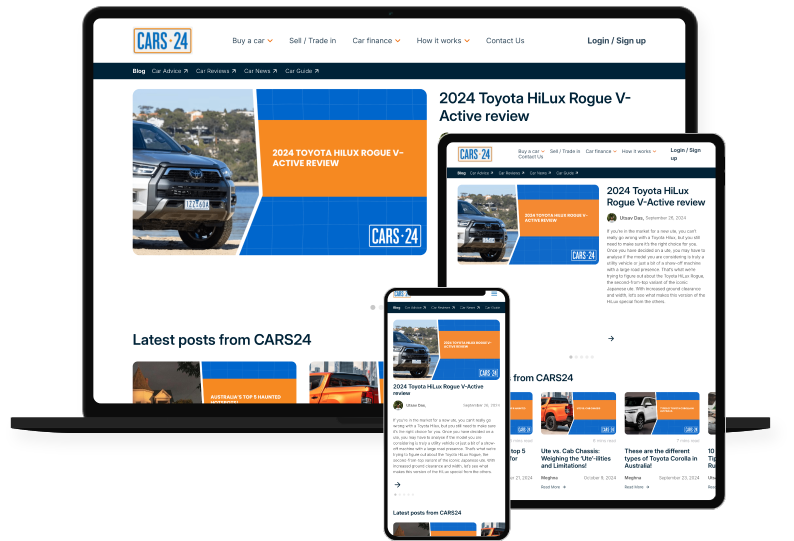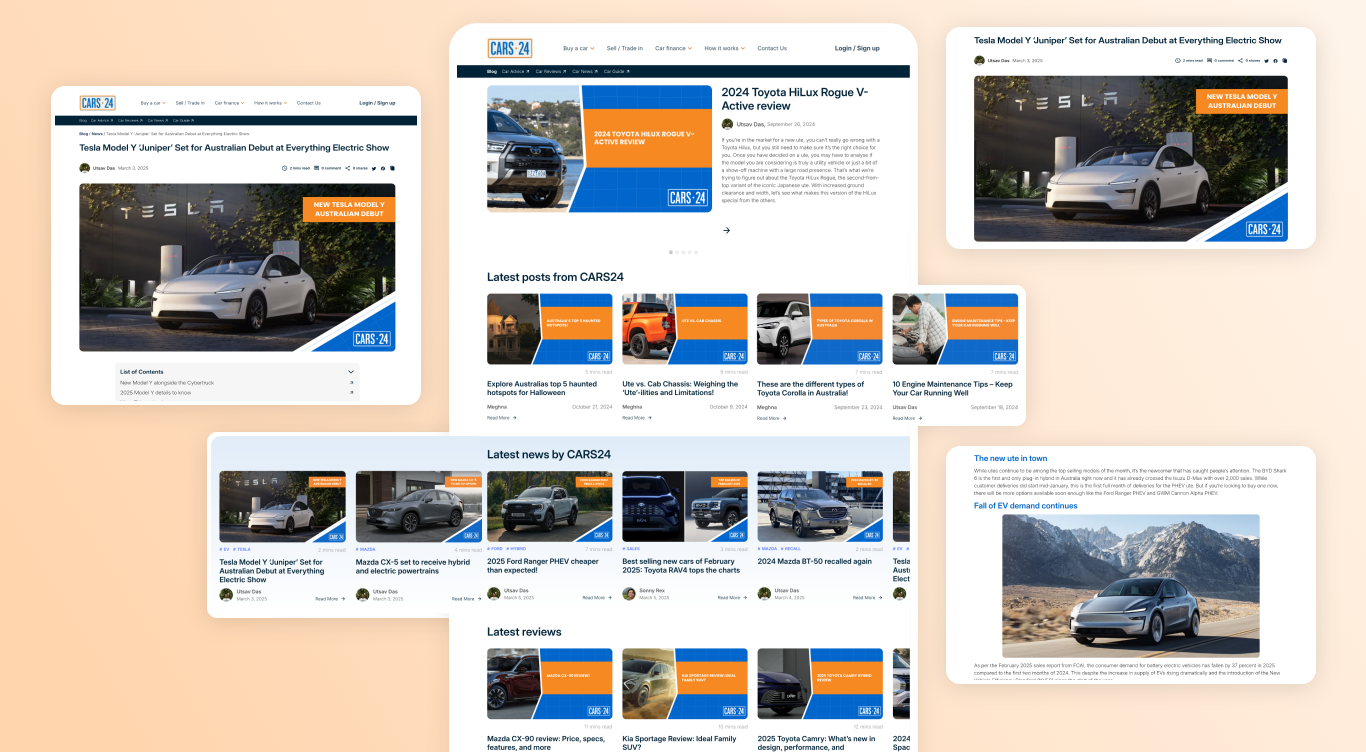From Ghost CMS to WordPress: Migrating and Revamping the Cars24 Australia Blog

About the Client/Project
- Location
- Pune, India
- Project Duration
- 15 Weeks
- Industry
- Technology
- Team Size
- 13
- Work Type
- Development, DevOps, Migration
Cars24 - Revolutionising the pre-owned car industry with innovative technologies & a commitment to customer.
CARS24 is a leading AutoTech company streamlining and revolutionising the sale, purchase, and financing of pre-owned cars in India, Australia and UAE. Leveraging a Smart AI Pricing Engine, and 140 quality checks, selling and buying pre-owned vehicles is seamless and transparent with CARS24.
Website URL : www.cars24.com.au/blog
Problem Statement and Solution
Problem Statement
Cars24 Australia’s blog was built on the Ghost CMS, which presented several limitations.
- Ghost version 4.3 was used, which reached end-of-life in 2023.
- The Ghost visual editor offered only linear content blocks (text, images, embeds), with no drag-and-drop page builder.
- All blogs were published under a single structure within a /blog silo, which limited content discoverability, filtering, and SEO scalability.
- Ghost supports only a single “Post” (for blogs) content type with a title, body, featured image, and tags. The marketing team of the Cars24 Australia blog required support for custom layouts for car reviews, car advice, car news and car guides, but none was available natively
- Marketing teams could not independently make structural changes to the blog quickly.
- Ghost CMS offers a predefined set of editor cards, like images, Markdown, HTML, galleries, dividers, and calls to action—20 of them. While these cover basic needs, they fall short when marketing teams require custom-designed & interactive content elements.
- The lack of robust SEO tools meant missed opportunities in organic search visibility.
Solution
The primary goal was a full-scale migration from Ghost to a custom WordPress blog, built with performance, flexibility, and marketing agility in mind. While the main Cars24 website remains on a different platform, the blog now runs entirely on WordPress, enabling independent content operations at scale.
The impact has been transformational. The Cars24 marketing team now manages the blog autonomously, publishing and updating posts without developer dependency.
With the custom Gutenberg blocks that we developed, their marketing team can create modular, visually engaging blog content faster, dramatically reducing the time from concept to published content.
We successfully migrated the blog from Ghost to WordPress, delivering:
- SEO Preservation and enhancement of all existing content
- Full design and layout flexibility to support evolving branding and UX needs
- Integration of advanced SEO to drive organic growth and insights
- Empowerment of the marketing team with intuitive content control and publishing workflows
- A marketer-friendly backend, eliminating the need for a dedicated in-house WordPress tech team
The project involved the development of approximately 11 unique page templates, covering a total of 15 pages, along with the successful migration of over 250 blog posts from Ghost to WordPress.
Approach we took
Mission, Vision, Development and Migration
Our strategy was to ensure a smooth migration while maintaining design precision and technical excellence. This meant not just building a new website but transforming the way Cars24’s content team managed and published their blog content.
To accomplish this, we carefully aligned ourselves with Cars24’s marketing, development, and SEO goals from the very beginning.
The Approach
1. Discovery & Research
- Our team started by thoroughly auditing the existing Ghost blog, everything from content structure, URL patterns, metadata, and much more.
- All the posts, authors, tags, and media assets were mapped, and content relationships were also reviewed to make sure nothing was lost in translation.
- The Figma designs for both mobile and desktop layouts were provided by the Cars24 design team, which helped jumpstart the design translation phase.
2. Design Translation
- This stage was one of the most important phases, as the client wanted to build a clean and modern version of the blog.
- The client provided detailed Figma files for both mobile and desktop layouts, which served as the foundation. This helped us kickstart the front-end work without delay.
- Our WordPress experts did an excellent job translating those static Figma designs, covering 11 unique pages, into pixel-perfect, reusable custom WordPress templates.
- The new blog is fully responsive and mobile-first, ensuring it looks great across all devices and screen sizes.
3. Content Migration
- The content migration process was both meticulous and methodical. Our team ensured that all content from our Ghost blog, over 250 posts, was successfully migrated into WordPress, with full preservation of structure, metadata, and formatting.
- All the content from Ghost CMS was exported in JSON format. It was then converted into WordPress-compatible XML files.
- These XMLs were segmented based on custom Post Types (CPTs), such as Car Reviews, Car Advice, etc.
- Each file was then carefully edited and imported into its relevant CPT in WordPress.
- All the tags, authors, and SEO metadata were properly mapped to ensure continuity.
- The Cars24 team recreated and re-uploaded all the images for the blog posts, as they wanted different dimensions and formats for the new blog.
4. SEO preservation
- SEO was a critical priority for the client. They had already built significant equity with the existing blog, and they couldn’t afford to lose traffic or rankings during the move.
- Our team took a methodical approach to preserving the SEO on the new site.
- All existing blog URLs were carefully mapped to their new counterparts, transitioning from a single /blog silo to a more structured hierarchy of URLs like /car-reviews/, /car-advice/, /car-news/, and /car-guide/. This significantly improved content discoverability.
- 301 redirects were implemented and verified across the board, ensuring SEO equity is maintained and avoiding broken links.
- Also, clickable breadcrumb navigation was implemented in the format Blogs > Category > Blog Title.
- Structured data is added through schema markup for FAQs, Breadcrumbs, and BlogPosting.
- The old blog didn’t have accurate or consistent tags; we recommended manual re-tagging, which their internal content team took up.
5. Custom Gutenberg Blocks Development
- 15+ custom Gutenberg blocks were developed, purpose-built to meet specific blog content needs. These blocks cover everything from post slider cards, subscriber forms, post grids, CTA sections, comparison tables, FAQs, and more.
- Drag-and-drop components gave the flexibility to create visually rich and structured blog posts across categories like car reviews, advice, news, and guides
- The marketing team moved from a linear, restricted editor in Ghost to a truly dynamic content experience in WordPress.
- Also, our developers worked together with the client’s stakeholders to implement custom content workflows. For example, if a particular blog category requires multiple Gutenberg blocks to be filled out, like specifications in car reviews, the system prevents publishing unless all required fields are completed. This ensures content quality and consistency across the board.
- Jetpack Akismet Anti-spam is used to filter out malicious or bot-driven comments.
6. Additional Blog Features
- When a user logs in on the main site, they’re automatically logged in on the /blog as well. That continuity in user experience ensures a seamless transition between platforms without repeated authentication.
- The blog listing features inventory pulled directly from the main site using APIs, allowing real-time car listings to be displayed effortlessly on the blog listing.
- Navigation consistency is preserved across both platforms by syncing the menu from the main site to the WordPress blog. Even though the main site uses a custom-built navigation system and WordPress has its own menu manager, we built a custom bridge to ensure both reflect the same structure for a unified user experience.
- Users can comment on blogs and leave reviews in the car-reviews category without logging in. They simply enter their name, comment or review, and a rating; no account is required.
- The blog sitemap is rewritten so that it shows the main domain’s blog URL instead of the blog server’s internal URL
7. DevOps Setup
- URL mapping of the /blog is done using a reverse proxy, which is hosted in a Docker container.
- A staging instance is used to preview and test updates before they go live, with synced data. This mirrors the production environment for reliable QA testing.
- Enforced best practices for security: file permissions, user roles, firewalls, and much more.
8. QA & Launch
- Our team conducted comprehensive QA before going live, including cross-browser testing, mobile responsiveness checks, and validation of all redirects, SEO elements, and key user journeys such as commenting and reviews.
- We tested the entire blog thoroughly to ensure accurate content formatting, proper interlinking, schema implementation, and optimal page load speeds.
- The launch itself was smooth, thanks to a well-defined rollout plan. This included a detailed staging-to-production checklist, URL verification after setting up the reverse proxy, sitemap submission to search engines, and continuous post-launch monitoring for any traffic or SEO anomalies. Performance and stability were closely observed during the first 72 hours.
- Post-launch, we conducted a training session and provided documentation for the client’s marketing team. They were trained on how to manage content using the custom Gutenberg blocks, empowering them to independently publish, update, and organize blog posts without relying on developers.
Team Size and Composition
Developers
6
Designers
2
Project Manager
1
Webmaster
1
DevOps
3
Business
2
Features / UI Highlights

Result and Metrics
Quantitative
100% content retention with SEO integrity fully preserved. Page load speed improved by 58% (reduced from 2.9s to 1.2s on average). 10+ unique page templates custom-built for the blog. Zero vulnerabilities were reported post-launch, reflecting a hardened security setup. Immediate content team adoption due to the intuitive WordPress interface and custom Gutenberg blocks.
Qualitative
Migrating from Ghost CMS to WordPress was a strategic decision that unlocked full control, performance, and scalability for the Cars24 Australia blog. With a custom-built WordPress site backed by seamless DevOps, optimized SEO, and flexible design, we turned a limited content platform into a marketing powerhouse.
Testimonial
“We needed more than just a new blog; we needed a content engine. The WPoets team didn’t just migrate our blog; they made it better, faster, and future-proof. It’s now a platform our content team enjoys working on every day.”
